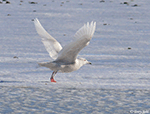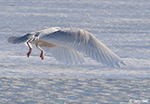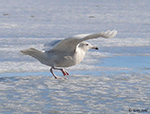| Length: 29 inches | Wingspan: 60 inches | Seasonality: Migrant / Winter |
| ID Keys: Large size, very pale gray back, nearly white elsewhere, pink legs, red spot on bill | ||
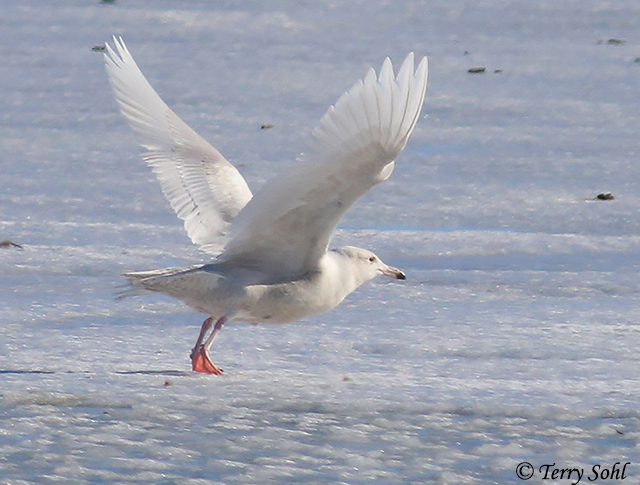 The
Glaucous Gull is a large, very pale gull of the high Arctic, 2nd in size only to
the Great Black-backed Gull. It is the
only large gull commonly found in the far north, where they are often in and
around mixed species breeding colonies that include other far northern Arctic
birds. Small numbers, often juveniles, move well south in the winter,
including into South Dakota, where they are most often encountered in and around
the open waters below the Missouri River dams.
The
Glaucous Gull is a large, very pale gull of the high Arctic, 2nd in size only to
the Great Black-backed Gull. It is the
only large gull commonly found in the far north, where they are often in and
around mixed species breeding colonies that include other far northern Arctic
birds. Small numbers, often juveniles, move well south in the winter,
including into South Dakota, where they are most often encountered in and around
the open waters below the Missouri River dams.
Habitat:
Glaucous Gulls are are generally a coastal bird, with most breeding occurring on coastal cliffs and other protected areas near the shoreline. Smaller numbers may breed inland in protected areas, such as on an island with limited access to ground predators. During the summer breeding season they stay near the coastline, foraging on the shoreline or it's surrounding waters. During migration or during the winter months, they may use a much wider variety of habitats. They are still primarily found in coastal areas, but may also use larger river systems or inland lakes on occasion. Some birds will stay in their far northern Arctic haunts all season long if open water is available.
Diet:
Omnivorous. Glaucous Gulls do seem to have a fondness for eggs, and may eat large numbers of eggs and young birds during breeding season. They will also eats large amounts of fish, mollusks and crustaceans. Other items include small mammals, insects, seaweed, berries, carrion, and refuse.
Behavior:
As with other gull species, Glaucous Gulls are often quite gregarious outside the breeding season, being found in conjunction with members of their own species, or other gull species. Foraging techniques depend upon location and food availability, but as omnivores, they'll adapt to the local food source and feed accordingly. As with other gulls, they will sometimes gather at landfills to feed on refuse.
Breeding:
Non-breeder in South Dakota. On their high arctic breeding grounds, Glaucous Gulls primarily breed on protected cliff faces or near the top of a cliff, in an area that offers some protections from ground predators. They also will sometimes nest in other protected locations such as an island that limits access to ground predators. They're not necessarily colonial nesters as a single breeding pair may nest well away from other Glaucous Gulls, but they are sometimes found in loose colonies, often near other seabird breeding areas.
Couples are thought to be monogamous and often return to the same nesting site year after year. The nest itself is a large bowl, built of a variety of vegetative material, depending on the site and what's available. It may include grasses, mosses, lichens, seaweed, feathers, and often, bits of debris found on the shoreline. The female lays 2 or 3 eggs, with both the male and female helping to incubate them. The young hatch after about 25 days, with both parents tending to the young, protecting, them, and feeding them.
Song:
Glaucous Gulls are capable of a variety of vocalizations, including a typical kyeer gull-like call, as well as various nasal-sounding calls and clucking.
- Click here to hear a clucking-like call from a Glaucous Gull1
- Click here to hear a typical kyeer calling of multiple Glaucous Gulls2
- Click here to hear a braying-like call of a glaucous Gull3
Migration:
Glaucous Gulls summers in the high Arctic. In winter, some birds move south along the Canadian and U.S. Coasts, around the Great Lakes, and occasionally elsewhere. Some birds do stay in the extreme north in winter, as long as open water is available.
Interactive eBird map:
Click here to access an interactive eBird map of Glaucous Gull sightings
Similar Species:
Glaucous Gulls are similar in structure to many gull species. Some general identification tips for a number of similar gulls can be found here: Identification of gull species is also complicated by the different plumages of juvenile birds, with some species taking 3 years to reach full adult plumage. Here are the two species most likely to be confused with a Glaucous Gull in South Dakota.
- Iceland Gull - Adult plumaged birds of both species have a pale gray mantle and white underparts and head, with a generally pale appearance compared to other similar gull species. When the wings are spread distinguishing between the two species is easier, as Glaucous Gulls in all ages and plumages have white wing tips, while those of an Iceland Gull generally have shades of gray. Iceland Gulls are also smaller birds than a Glaucous Gull (although size alone can be a difficult factor to judge, unless both species happen to be seen side-by-side). Iceland gulls have a less robust bill than that of a Glaucous Gull.
- Glaucous-Winged Gull - Glaucous-winged Gulls are another gull species with a similar pale gray mantle to a Glaucous Gull, and white underparts and head. Glaucous-winged Gull adults have gray wingtips with white spots, compared to the white wingtips of a Glaucous Gull (in all plumages).
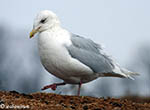 |
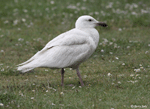 |
 |
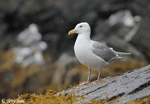 |
| Iceland Gull (adult plumage) | Glaucous-winged Gull (juvenile plumage) | Glaucous-winged Gull (adult plumage) | Glaucous-winged Gull (adult plumage) |
Conservation Status:
Systematic surveys in the last few decades indicate generally stable populations. The Glaucous Gull's normal range makes it less vulnerable to human activities than many bird species. They are found across a very broad geographic area, are common in many parts of their range, and there are no perceived long-term threats at the current time. The IUCN considers the Glaucous Gull to be a species of "Least concern".
South Dakota "Hotspot":
Not all, but a majority of Glaucous Gull sightings in South Dakota have occurred below the Missouri River dams during the winter. The four dams are Oahe Dam near Pierre, Big Bend dam near Fort Thompson, the Fort Randall dam near Pickstown, and Gavin's Point Dam near Yankton. Most birds that are seen in South Dakota during the winter months are young, juvenile plumaged birds.
Further Information:
- USGS Patuxent Bird Identification InfoCenter, Glaucous Gull
- WhatBird - Glaucous Gull
- Audubon Guide - Glaucous Gull
Photo Information:
January 4th, 2019 - Below Oahe Dam near Pierre, South Dakota - Terry L. Sohl
Audio File Credits:
- 1Stanislas Wroza. Recorded in western Iceland on July 17th, 2018. Original recording and information available from xeno-canto.
- 2Stein O. Nilsen. Recorded in Svalbard, Norway on June 3rd, 2018. Original recording and information available from xeno-canto.
- 3Andrew Spencer. Recorded in Japan on December 26th, 2013. Original recording and information available from xeno-canto.
| Click on the map below for a higher-resolution view |
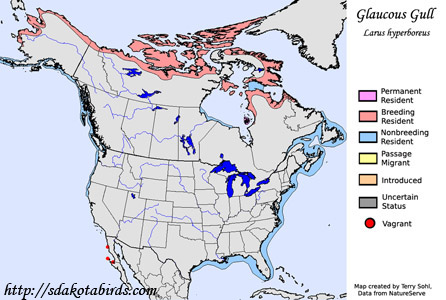 |
| South Dakota Status: Uncommon winter visitor and migrant, most commonly sighted along the Missouri River and its reservoirs. |
Additional Glaucous Gull Photos
